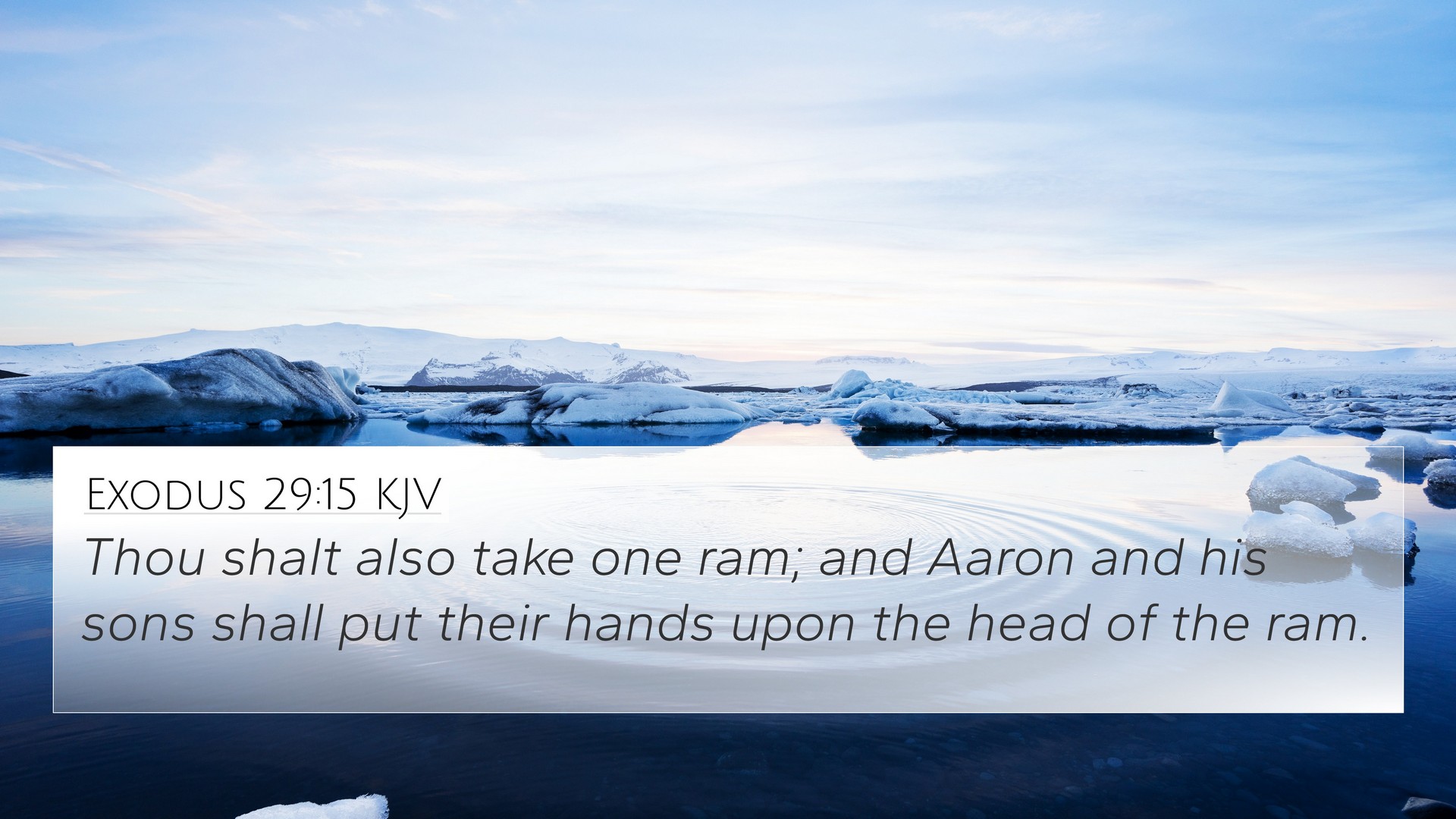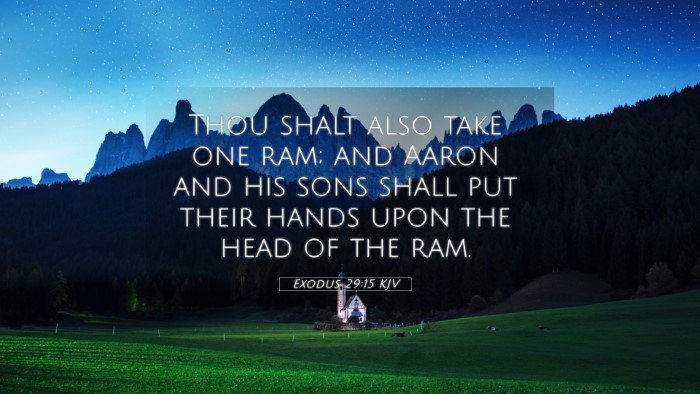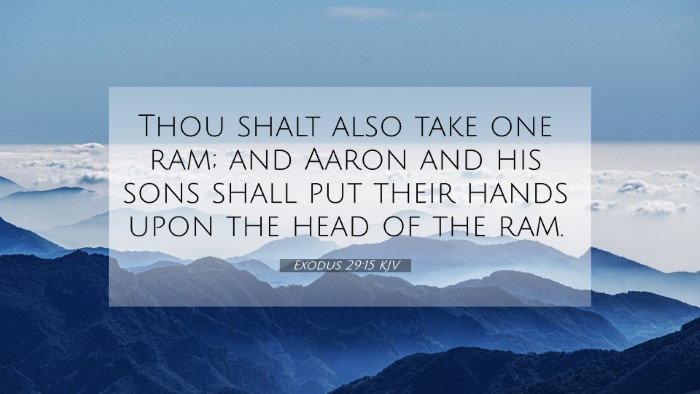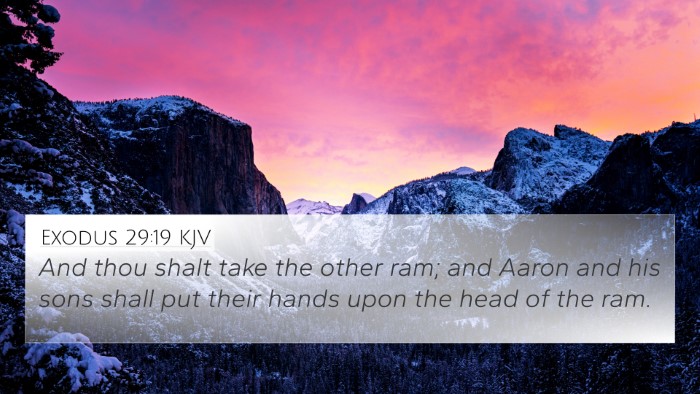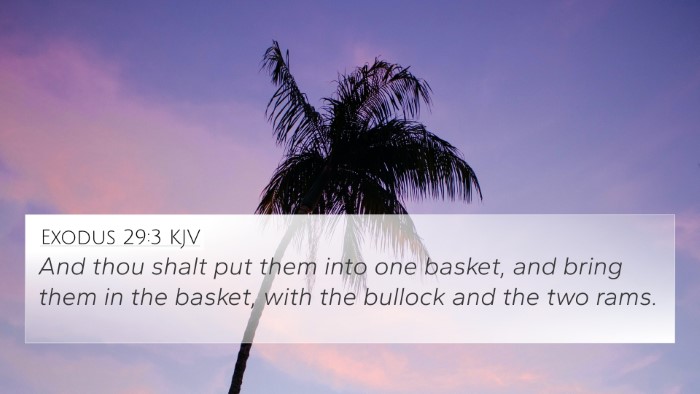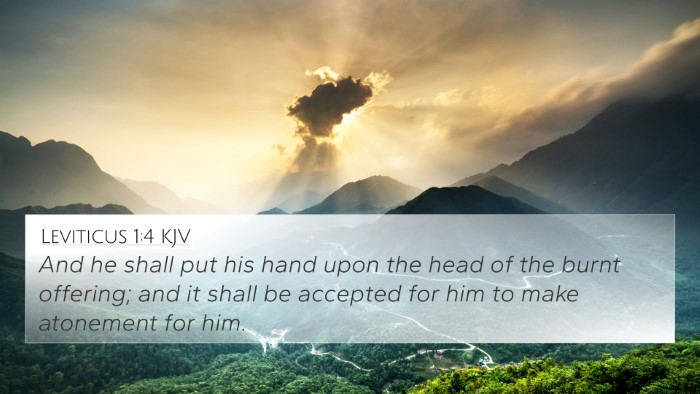Exodus 29:15 - Summary and Interpretation
Exodus 29:15 states: "Thou shalt also take one ram; and Aaron and his sons shall put their hands upon the head of the ram." This verse is a part of the consecration of the priests, and it holds significant meaning in the context of biblical rituals and the establishment of the priesthood.
Understanding the Context
The context of Exodus 29 outlines the ordination ceremony for Aaron and his sons as priests. This ritual was essential for establishing their role in mediating between God and the people of Israel. The placement of hands on the ram symbolizes the transfer of sin and the act of dedicating the animal for sacrifice.
Key Insights from Public Domain Commentaries
- Matthew Henry: Henry emphasizes the importance of the act of laying hands on the ram, which signifies the identification of the priests with the sacrifice. This act illustrates the concept of substitutionary atonement, where the ram takes upon itself the role of bearing the sins of the priests.
- Albert Barnes: Barnes notes that this element of the ceremony reflects the need for atonement and consecration within the priestly service. The ram is not only a sacrifice but also represents a vessel through which holiness is imparted to the priests.
- Adam Clarke: Clarke elaborates on the notion of the ram being a symbol of God’s provision and the seriousness of consecrating someone for divine service. This ritual sets a precedent for future sacrificial practices in Israel.
Theological Implications
The act described in Exodus 29:15 provides a deep theological insight into the nature of sacrifice and atonement in biblical tradition. The laying on of hands is a gesture that signifies the transfer of responsibility and the serious nature of the sacrificial offering. It reflects a deeper truth about sin, guilt, and the need for a mediator.
Connections Between Bible Verses
Exodus 29:15 is a pivotal passage, linking various themes throughout Scriptures. Here are some notable cross-references that help elucidate its meaning:
- Leviticus 4:15: Similar laying of hands on the sacrificial animal, emphasizing the concept of sin transfer.
- Hebrews 7:27: References Christ’s perfect sacrifice, contrasting the need for repeated animal sacrifices in the priesthood.
- Romans 6:10: Highlights the significance of Christ’s sacrifice and how it relates to atonement.
- John 1:29: John the Baptist identifies Jesus as the Lamb of God, drawing a parallel to sacrificial lambs in Levitical law.
- 1 Peter 2:5: Describes believers as a holy priesthood, echoing the themes in Exodus regarding consecration.
- Isaiah 53:6: Foretells the sacrificial nature of the Messiah, connecting with the themes of substitution in Exodus 29.
- 2 Corinthians 5:21: Discusses Christ's role as sin for us, paralleling the concept of substitution in sacrificial rites.
Comparative Bible Verse Analysis
In analyzing Exodus 29:15 alongside these cross-references, a thematic study emerges. The continuity of sacrificial practices points towards a profound understanding of atonement within the biblical narrative. Authors of the New Testament drew heavily from these Old Testament sacrificial images to articulate the new covenant established through Christ's sacrifice.
Applications and Reflections
For believers today, the implications of Exodus 29:15 resonate through themes of mediation, sacrifice, and consecration. Understanding these connections deepens our appreciation of the sacrificial system in Israel, paving the way for understanding Christ’s ultimate sacrifice that fulfills these representations.
Tools for Bible Cross-Referencing
When studying such verses, utilizing tools for Bible cross-referencing can enhance understanding:
- Bible Concordance: Helps locate verses thematically or by specific terms.
- Bible Cross-Reference Guide: Provides systematic connections between related scriptures.
- Bible Chain References: Follows a path of scripture that elaborates on a singular theme or doctrine.
Conclusion
Exodus 29:15 offers a vital insight into the foundations of priestly duties and sacrificial practices while establishing a significant link to New Testament theology. By understanding these interconnections and using cross-referencing tools, readers can unlock the deeper meanings of biblical texts and appreciate the intricate dialogue that exists across Scriptures.
